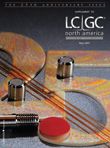Corporate Retrospective 2007: Hitachi
Born from the garages of entrepreneurs, the analytical instrumentation industry's first 25 years were marked by invention and the establishment of core technologies. Invention continues, but the past 25 years are better characterized as a time of perfecting and reengineering, pushing limits, and consolidation - of the technologies and the industry. The specifications arms race continues as the players try to stay on technology's leading edge, but new technology introductions have been rare. Instead, the industry debuts faster, smaller, and more economical products that are customer-focused and user friendly. Hybridization is becoming common. An industry once driven by inward facing R&D departments is now driven by market demands.
Born from the garages of entrepreneurs, the analytical instrumentation industry's first 25 years were marked by invention and the establishment of core technologies. Invention continues, but the past 25 years are better characterized as a time of perfecting and reengineering, pushing limits, and consolidation - of the technologies and the industry. The specifications arms race continues as the players try to stay on technology's leading edge, but new technology introductions have been rare. Instead, the industry debuts faster, smaller, and more economical products that are customer-focused and user friendly. Hybridization is becoming common. An industry once driven by inward facing R&D departments is now driven by market demands.

Industry challenges: "Do more, with less, faster." The recent focus on cost cutting, hyper efficiency, and ultra-lean operations has forced companies to examine their operations. Purchasing departments have recognized the inherent economy of supplier reduction, and qualified vendor lists have become the norm. Suppliers that offer the broadest range of products and services have a competitive edge - driving consolidation.
Also driving consolidation is the margin pressures of a mature market. Margins continue to erode, particularly on the core product - the hardware. The products now exceed customers' needs, and differentiating a product on the basis of hardware specifications is growing difficult. As this continues, selling instruments directly to an end-user is becoming less profitable. Vendors are responding by moving manufacturing to lower-cost locations, outsourcing, leaning down their operations, and going to where the profit is - consumables, software, and services. Traditional hardware providers are acquiring consumable and software companies while marketing their growing portfolio of service-related products.
Consolidation will continue, but so will technological progress. Look for more hybridization and miniaturization, and the universal analyzer - it's right around the corner. The survivors will be customer-focused vendors who provide smaller, faster, and less expensive tools. The real winner will be the customer as scientific tools become more powerful, more accessible, and more relevant.
Congratulations to LCGC on their 25th anniversary.
David Jorissen
Senior Product Marketing Manager, HPLC
Hitachi High Technologies America, Inc.
San Jose, California

Determining Neurotransmitters in Spinal Cords with UHPLC
February 18th 2025Researchers at Jilin University (Changchun, China) developed a highly sensitive, rapid, and accurate method for analyzing neurotransmitters (NTs) in rat spinal cord tissue. Ultra-high performance liquid chromatography-triple quadrupole tandem mass spectrometry (UHPLC-QqQ-MS/MS) in conjunction with ultra-ionic liquid dispersive liquid-liquid microextraction (UA-MIL-DLLME) were used to extract NTs for analysis.
The Next Frontier for Mass Spectrometry: Maximizing Ion Utilization
January 20th 2025In this podcast, Daniel DeBord, CTO of MOBILion Systems, describes a new high resolution mass spectrometry approach that promises to increase speed and sensitivity in omics applications. MOBILion recently introduced the PAMAF mode of operation, which stands for parallel accumulation with mobility aligned fragmentation. It substantially increases the fraction of ions used for mass spectrometry analysis by replacing the functionality of the quadrupole with high resolution ion mobility. Listen to learn more about this exciting new development.
Revolutionizing LC-MS with Next-Gen Separation for Cyclic Peptide Analysis
February 17th 2025Cyclic peptides, known for their stability and high specificity, are promising therapeutic agents in the fight against cancer, infections, and autoimmune diseases. However, developing effective cyclic peptides presents numerous challenges, including poor pharmacokinetics, efficacy, and toxicity. Traditional methods like liquid chromatography tandem-mass spectrometry (LC-MS/MS) often struggle with resolving isomeric linear peptide metabolites, posing significant risks in safety, efficacy, and regulatory approval. In this paper, Komal Kedia, PhD, will share how she leveraged MOBIE’s high-resolution ion mobility-mass spectrometry (IM-MS) system to achieve a 72% reduction in run times, 200% greater resolving power, and enhanced accuracy in identifying “soft spots” prone to enzymatic degradation.
























